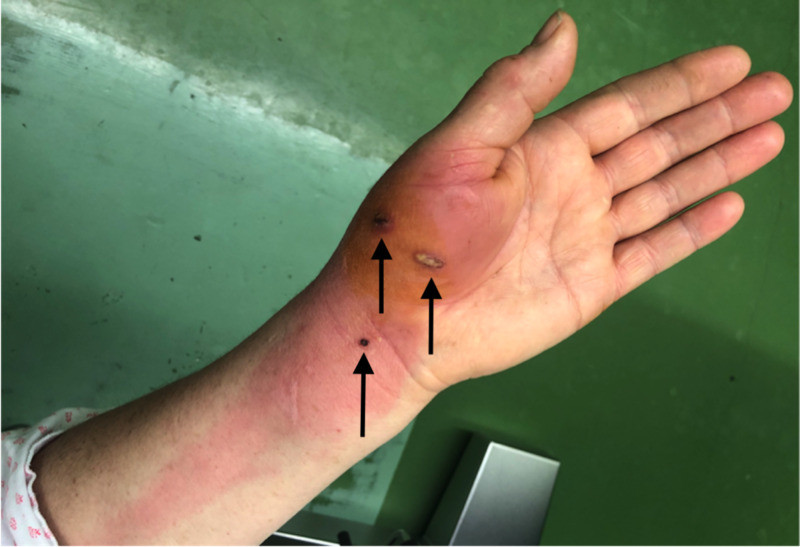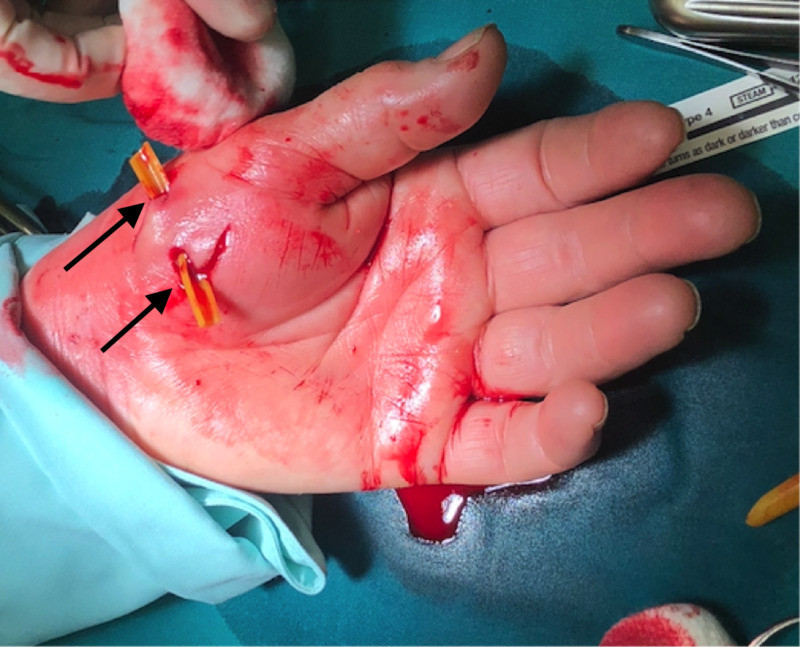Introduction
Animal bites are a common reason for emergency room visits, with cat bites being particularly noteworthy. While dog bites are more frequent, cat bites are responsible for a significant majority – about three-quarters – of bite wounds that become infected. It’s easy to underestimate the potential danger of a cat bite because the initial wound may appear minor. However, cats possess sharp, needle-like teeth that can penetrate deeply into tissues, bones, and joints. These puncture wounds introduce saliva and bacteria deep into the body, creating an environment ripe for infection. This article explores a case of a serious Cat Bite Infection to highlight the risks, symptoms, and necessary treatments.
The Underestimated Danger of Cat Bites
Cat bites often seem less serious than dog bites due to the smaller size of the animal and the seemingly superficial nature of the injury. However, this perception can be misleading. A cat’s teeth are designed for piercing, and they can deliver bacteria deep beneath the skin’s surface. This deep inoculation, coupled with the potential for the wound to close quickly trapping bacteria inside, makes cat bites highly prone to infection. Without prompt and appropriate care, a cat bite infection can escalate rapidly, leading to significant health issues.
Case Presentation: A Severe Cat Bite Infection
Consider the case of a 60-year-old woman who sought medical attention after being bitten by her cat. A day after the incident, she developed a fever (38.5°C or 101.3°F), general discomfort, and noticeable wounds on her right hand and wrist. These weren’t just superficial scratches; they were deep puncture wounds accompanied by significant redness, swelling, and intense pain. Alarmingly, a red streak was extending up her arm towards her elbow, indicating lymphangitis – an infection of the lymphatic vessels.
Upon examination, the patient reported severe pain (8 out of 10 on a visual pain scale) and reduced sensation around the bite area. Her medical history included a significant smoking habit. Blood tests revealed elevated white blood cell counts (15.8×109/L, normal range: 4.0-10.0×109/L) and a strikingly high C-reactive protein level (224.9 mg/L, normal: <2 mg/L), both indicators of a serious infection. She was admitted to the hospital following initial surgical treatment. After a few days of inpatient care, she improved clinically and was discharged, with follow-up appointments scheduled.
Figure 1. Visible signs of a cat bite infection: Erythema, edema, and lymphangitis on the hand and wrist.
 Cat bite infection symptoms on hand
Cat bite infection symptoms on hand
This image depicts the severity of a cat bite infection, showing the erythema (redness) and edema (swelling) around the wounds, as well as the lymphangitis, indicated by the red streak extending up the arm. These are classic signs of a spreading infection requiring immediate medical attention.
Figure 2. Surgical intervention: Debridement, irrigation, and catheter placement for drainage of cat bite wounds.
 Surgical debridement and irrigation of cat bite
Surgical debridement and irrigation of cat bite
This image illustrates the surgical treatment necessary for severe cat bite infections. Debridement involves removing dead or infected tissue, while irrigation cleanses the wound. Catheter placement facilitates ongoing drainage to promote healing and prevent further infection.
Why Hands are Vulnerable to Cat Bite Infections
The hand is particularly susceptible to complications from cat bites due to its complex anatomy. It’s densely packed with tendons, joints, blood vessels, and nerves, all located close to the surface, protected by only a thin layer of soft tissue. This intricate structure makes the hand vulnerable to deep infections from penetrating cat bites. As seen in the presented case, the long, slender teeth of cats can easily introduce bacteria into these deeper structures, leading to rapid cellulitis (skin infection) and lymphangitis.
Studies indicate that a significant percentage of animal bites, ranging from 45% to 65%, affect the hands and wrists. These bites often occur during seemingly harmless interactions like petting or feeding, as was the case with the patient described. Interestingly, research suggests women are bitten by cats more frequently than men, potentially due to differences in how people interact with and care for cats.
Common Bacteria Involved in Cat Bite Infections
Pasteurella species are frequently identified as the primary culprits in bite wound infections in general. In cat bite infections specifically, Pasteurella is often followed by other bacteria such as Streptococci, Staphylococci, Neisseria, and Moraxella species. Furthermore, cats are known carriers of Bartonella henselae, the bacterium responsible for cat scratch disease. In this particular case, serological testing confirmed Bartonella henselae as a contributing factor in the patient’s infection.
Cat scratch disease is often associated with scratches, but bites are also a known mode of transmission. Whether a cat primarily lives indoors or outdoors can influence its likelihood of carrying and transmitting infectious organisms. Bartonella henselae transmission among cats is often facilitated by cat fleas (Ctenocephalides felis). It’s also worth noting that in cases where Bartonella henselae serology is negative, another Bartonella species, Bartonella clarridgeiae, should be considered as a potential cause of cat scratch disease following a cat bite.
Treatment Strategies for Cat Bite Infections
Effective treatment of a cat bite infection typically involves a combination of surgical intervention and antibiotic therapy. While the specifics of surgical timing and procedures are still being researched, the general approach is well-established. For Bartonella henselae infections, initial antibiotic treatment often involves a beta-lactam/beta-lactamase inhibitor combination, such as amoxicillin/clavulanic acid. This combination works by disrupting bacterial cell wall synthesis. Oral amoxicillin/clavulanic acid is frequently considered the first-line antibiotic for animal bites. For individuals with penicillin allergies, alternatives include fluoroquinolones or trimethoprim/sulfamethoxazole. Doxycycline can be used as an alternative for patients over 10 years old.
In some instances, imaging techniques like X-rays or MRI scans may be used to check for retained teeth fragments or other foreign material within the wound. While X-rays are readily available and cost-effective, they may not be highly sensitive for detecting infection, particularly osteomyelitis (bone infection). In the presented case, the treatment focused on surgical debridement and necrectomy (removal of dead tissue) along with antibiotic administration and close clinical and laboratory monitoring. Following established protocols for thenar space infections (infections in the palm of the hand), surgical drainage was performed through volar (palm-side) and dorsal (back-side) incisions. Careful identification and protection of neurovascular structures were crucial during the procedure. The infected tissue was excised to open the abscess cavity and reduce bacterial load. The wound was then thoroughly irrigated, a drainage catheter was placed, and the wound was closed and dressed with a compression bandage and plaster splint.
Conclusion: Prompt Action is Key to Preventing Complications
This case underscores the potential severity of cat bite infections, even when seemingly minor initially. In this instance, a progressive cat bite-associated cat-scratch disease affecting the patient’s hand was successfully treated with prompt surgical debridement, drainage, and empiric antibiotic therapy using amoxicillin/clavulanic acid. This timely intervention led to complete healing and preserved hand function. It is crucial to recognize that cat bites carry a significant risk of deep tissue infections in the hand, which can lead to serious and debilitating complications if not addressed promptly and effectively. Seeking medical attention for any cat bite, especially those that are deep or show signs of infection, is essential for preventing serious health consequences.
Disclaimer: This article is for informational purposes only and does not constitute medical advice. Always consult with a qualified healthcare professional for diagnosis and treatment of any medical condition.

